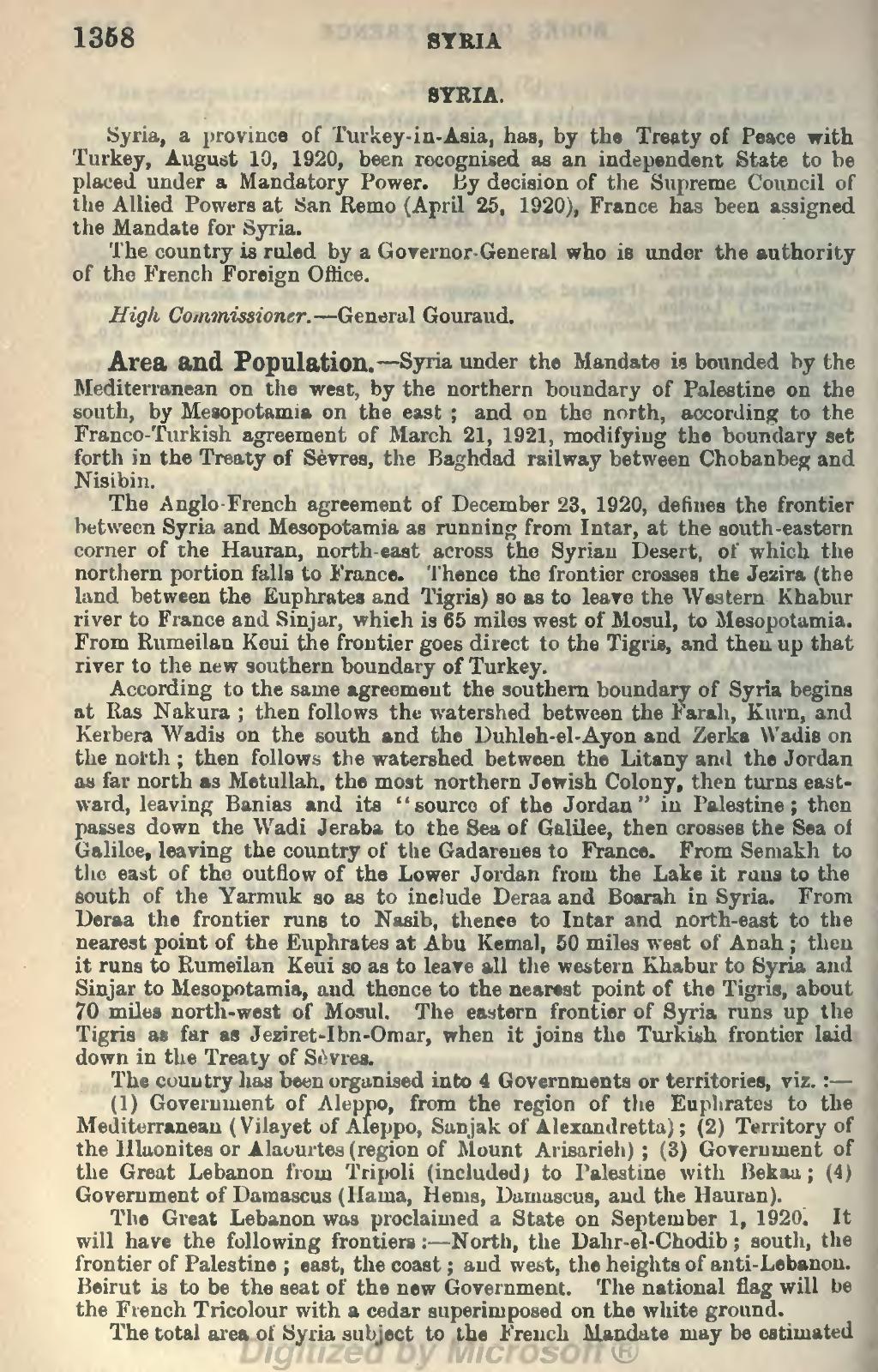SYRIA.
Syria, a province of Turkey-in-Asia, has, by the Treaty of Peace with Turkey, August 10, 1920, been recognised as an independent State to be placed under a Mandatory Power. By decision of the Supreme Council of the Allied Powers at San Remo (April 25, 1920), France has been assigned the Mandate for Syria.
The country is ruled by a Governor-General who is under the authority of the French Foreign Office.
High Commissioner.—General Gouraud.
Area and Population.—Syria under the Mandate is bounded by the Mediterranean on the west, by the northern boundary of Palestine on the south, by Mesopotamia on the east; and on the north, according to the Franco-Turkish agreement of March 21, 1921, modifying the boundary set forth in the Treaty of Sèvres, the Baghdad railway between Chobanbeg and Nisibin.
The Anglo-French agreement of December 23, 1920, defines the frontier between Syria and Mesopotamia as running from Intar, at the south-eastern corner of the Hauran, north-east across the Syrian Desert, of which the northern portion falls to France. Thence the frontier crosses the Jezira (the land between the Euphrates and Tigris) so as to leave the Western Khabur river to France and Sinjar, which is 65 miles west of Mosul, to Mesopotamia. From Rumeilan Keui the frontier goes direct to the Tigris, and then up that river to the new southern boundary of Turkey.
According to the same agreement the southern boundary of Syria begins at Ras Nakura; then follows the watershed between the Farah, Kurn, and Kerbera Wadis on the south and the Duhleh-el-Ayon and Zerka Wadis on the north; then follows the watershed between the Litany and the Jordan as far north as Metullah, the most northern Jewish Colony, then turns eastward, leaving Banias and its "source of the Jordan" in Palestine; then passes down the Wadi Jeraba to the Sea of Galilee, then crosses the Sea of Galilee, leaving the country of the Gadarenes to France. From Semakh to the east of the outflow of the Lower Jordan from the Lake it runs to the south of the Yarmuk so as to include Deraa and Bosrah in Syria. From Deraa the frontier runs to Nasib, thence to Intar and north-east to the nearest point of the Euphrates at Abu Kemal, 50 miles west of Anah; then it runs to Rumeilan Keui so as to leave all the western Khabur to Syria and Sinjar to Mesopotamia, and thence to the nearest point of the Tigris, about 70 miles north-west of Mosul. The eastern frontier of Syria runs up the Tigris as far as Jeziret-Ibn-Omar, when it joins the Turkish frontier laid down in the Treaty of Sèvres.
The country has been organised into 4 Governments or territories, viz.:—
(1) Government of Aleppo, from the region of the Euphrates to the Mediterranean (Vilayet of Aleppo, Sanjak of Alexandretta); (2) Territory of the Hlaonites or Alaourtes (region of Mount Arisarieh); (3) Government of the Great Lebanon from Tripoli (included) to Palestine with Bekaa; (4) Government of Damascus (Hama, Hems, Damascus, and the Hauran).
The Great Lebanon was proclaimed a State on September 1, 1920. It will have the following frontiers:—North, the Dahr-el-Chodib; south, the frontier of Palestine; east, the coast; and west, the heights of anti-Lebanon. Beirut is to be the seat of the new Government. The national flag will be the French Tricolour with a cedar superimposed on the white ground.
The total area of Syria subject to the French Mandate may be estimated
